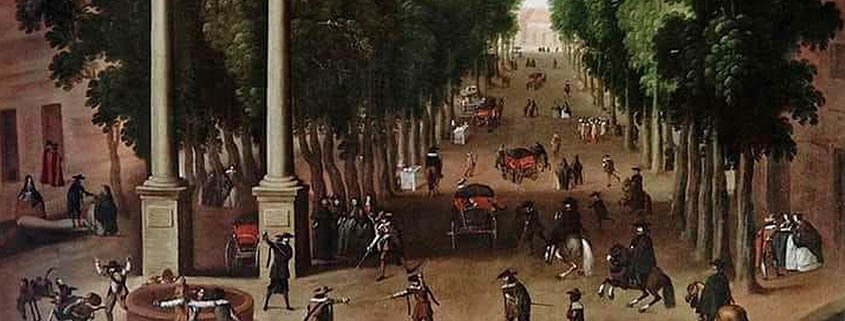Deprecated: mb_convert_encoding(): Handling HTML entities via mbstring is deprecated; use htmlspecialchars, htmlentities, or mb_encode_numericentity/mb_decode_numericentity instead in /home/u211400686/domains/tripinspain.com/public_html/wp-content/themes/acabado/functions.php on line 2160
The Alameda de Hercules (Hercules Center), or simply La Alameda, is a garden or square shopping centre in Seville, southern Spain. Built in 1574, it was initially a square with a pedestrian zone, named after the eight rows of white poplars (álamos in Spanish) that fill its central area.

Roman columns with statues of Hercules and Julius Caesar
It was Europe’s and Spain’s oldest public garden. It was situated between the Guadalquivir River and the Macarena neighbourhood on the northern edge of the city’s casco Antiguo (historic centre).
CONTENT
History
Before urbanization, Alameda Square was a natural section of the easternmost tributary of the Guadalquivir River. Leaving El Arenal, the route took in the Alameda and the city’s historic core on its way to Plaza Nueva. In 1383, a dam fed by an aquifer and regular river upwellings turned the river basin into a marshy pond.
In 1574, the Count of Barajas drained the water by building irrigation canals and fountains and planting lines of coastal white poplars. As a result, four columns were erected to mark the walk between the trees. It was initially planned to take four columns from the remains of a Roman temple on Marmoles Street, believed to be dedicated to Hercules. However, when the third column was moved, it fell apart, and the work was temporarily left unfinished. Consequently, the two columns at the square’s south end are from the original Roman temple, while the north is a modern reproduction. This project culminated in two sculptures on the two southern columns: Hercules (the mythological founder of Seville) and Julius Caesar (mentioned as the restorer of the city during Roman rule). In the second half of the eighteenth century, two additional statues of lions with shields representing Seville and Spain were placed on the northern columns.
In the late 19th century, Alameda was a meeting place for the upper classes, with many elegant theatres and stalls. However, after the civil war, Alameda began to suffer progressive deterioration and became one of the poorest neighbourhoods in Seville, troubled by prostitution and drugs. As of 1989, up to 35 brothels were located here.
After a gradual start to recovery in the early 21st century, La Alameda was redeveloped in 2006–2008 thanks to public funding from the City Council. Stop-and-go traffic patterns were implemented, and fountains, kiosks, and seating were implemented. In addition, white poplars and European carcasses were planted as part of the dam’s reconstruction. Since then, La Alameda has become one of Seville’s most popular entertainment districts.
Despite the flood protection infrastructure built in the plaza’s earlier transformation in the 16th and 17th centuries, La Alameda remained one of the city’s most flooded areas until the second half of the 20th century. Accordingly, during the Great Plague of 1649, it was reported that the Alameda was so inundated that people crossed the area in boats. Newly engineered changes to the Guadalquivir River’s channel system and the installation of a vast underground cistern to hold stormwater have improved drainage and prevented further flooding in the area.
Monuments and Buildings

The Roman columns that flank the waterfront at La Alameda aren’t the only attractions in the area. Located on its western side, the Casa de las Sirenas (which translates to “the mermaid’s home”) is a 19th-century French-style palace that now serves as a community centre for the locals by organizing exhibitions, seminars, lectures, and cultural events.
The chapel dedicated to Our Lady of the Carmen and the Cross of the Rodeo may be found at the northern end and serves as a prominent landmark. Being the site of the convent where Saint Dona Inés formerly resided, it was a significant source of inspiration for José Zorrilla’s drama Don Juan Tenorio. Romantic writer Gustavo Adolfo Becker was born not far from the Alameda, on the street named after the man responsible for restoring La Alameda, the Count of Barajas (Conde de Barajas).
Nightlife

The area has become Seville’s principal nightlife centre due to its vibrant alternative and eclectic atmosphere. Flamenco, metal, and funk performances are on the schedule at La Alameda. There are many places to eat and drink in the neighbourhood right near the water, including discos, old and new restaurants, pubs with tapas and drinks, cafes, and even Arabic-style teahouses. In addition, several gay-friendly bars and clubs may be found around La Alameda.
